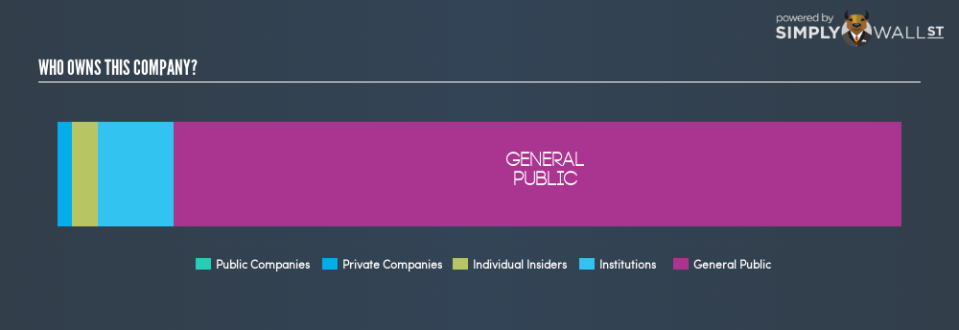Who Really Owns Alexco Resource Corp (TSE:AXR)?

In this article, I’m going to take a look at Alexco Resource Corp’s (TSE:AXR) latest ownership structure, a non-fundamental factor which is important, but remains a less discussed subject among investors. The impact of a company’s ownership structure affects both its short- and long-term performance. Since the effect of an active institutional investor with a similar ownership as a passive pension-fund can be vastly different on a company’s corporate governance and accountability of shareholders, investors should take a closer look at AXR’s shareholder registry.
View our latest analysis for Alexco Resource
Institutional Ownership
Institutional investors are one of the largest group of market participants and their buy-sell decisions on a company’s stock can significantly impact prices, more so, when there are relatively small amounts of shares available on the market to trade. A low institutional ownership of 8.95% puts AXR on a list of companies that are not likely exposed to spikes in volatility resulting from institutional trading. In addition, the fact that the company is covered by only 1 analyst indicates that it is yet to become popular amongst large sell-side institutions.
Insider Ownership
Insiders form a group of important ownership types as they manage the company’s operations and decide the best use of capital. Insider ownership has been linked to better alignment between management and shareholders. AXR insiders hold a not-so-significant 3.09% stake in the company, which somewhat aligns their interests with that of shareholders. However, a higher level of insider ownership has been linked to management executing on high-returning projects instead of expansion projects for the sake of apparent growth. It would also be interesting to check what insiders have been doing with their shareholding recently. Insider buying can be a positive indicator of future performance, but a selling decision can be simply driven by personal financial requirements.
General Public Ownership
The general public holds a substantial 86.11% stake in AXR, making it a highly popular stock among retail investors. This level of ownership gives retail investors the power to sway key policy decisions such as board composition, executive compensation, and potential acquisitions. This is a positive sign for an investor who wants to be involved in key decision-making of the company.
Private Company Ownership
Another group of owners that a potential investor in AXR should consider are private companies, with a stake of 1.80%. While they invest more often due to strategic interests, an investment can also be driven by capital gains through share price appreciation. However, an ownership of this size may be relatively insignificant, meaning that these shareholders may not have the potential to influence AXR’s business strategy. Thus, investors not need worry too much about the consequences of these holdings.
Next Steps:
Institutional ownership level and composition in AXR is not high nor active enough to significantly impact its investment thesis. However, ownership structure should not be the only focus of your research when constructing an investment thesis around AXR. Rather, you should be looking at fundamental drivers such as Alexco Resource’s past track record and financial health. I highly recommend you to complete your research by taking a look at the following:
Financial Health: Are AXR’s operations financially sustainable? Balance sheets can be hard to analyze, which is why we’ve done it for you. Check out our financial health checks here.
Past Track Record: Has AXR been consistently performing well irrespective of the ups and downs in the market? Go into more detail in the past performance analysis and take a look at the free visual representations of AXR’s historicals for more clarity.
Other High-Performing Stocks: Are there other stocks that provide better prospects with proven track records? Explore our free list of these great stocks here.
NB: Figures in this article are calculated using data from the last twelve months, which refer to the 12-month period ending on the last date of the month the financial statement is dated. This may not be consistent with full year annual report figures.
To help readers see past the short term volatility of the financial market, we aim to bring you a long-term focused research analysis purely driven by fundamental data. Note that our analysis does not factor in the latest price-sensitive company announcements.
The author is an independent contributor and at the time of publication had no position in the stocks mentioned. For errors that warrant correction please contact the editor at editorial-team@simplywallst.com.

